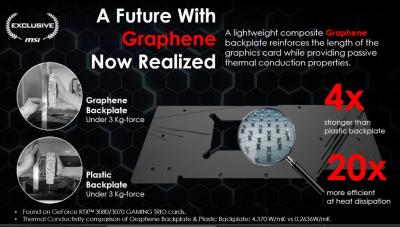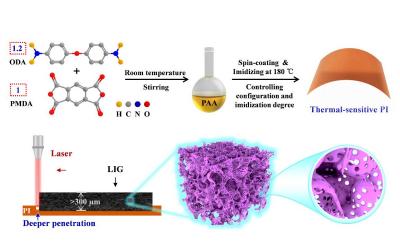The Graphene-Info newsletter, November 2020
Published: Tue, 12/01/20
GAC to test its "super-fast-charging battery" in production vehicles
After announcing its plan (In May 2020) to mass produce graphene-enhanced battery for EVs by the end of 2020, and setting up a unit that specializes in graphene and has begun R&D of fast-charging technology for EVs in September 2020, GAC has now stated that it expects to test its battery in production vehicles by the end of this year, however - whether it can eventually be put into mass production will have to await the results of real-vehicle testing.
According to GAC's claim, the graphene "super-fast-charging battery" can be recharged to 85 percent in just eight minutes. If this proves to be true, the charging time will be comparable to the refueling time of traditional fuel cars, which by itself will be great news for the EV market.
MSI is now shipping its graphene-enhanced backplate RTX 3000 graphic cards
Last month MSI revealed that it is utilizing graphene composites in its RTX 3000 series GPUs. The new graphic cards are now shipping globally (the cost in the US is $1,699).
MSI uses a graphene composite material as the backplate of the GPU, which is traditionally made of plastic. MSI says that the graphene composite is 4X stronger than its previous plastic backplate, and offers much higher (20X) heat dissipation performance.
NanoEMI to work with Ericsson on validation of its technology in telecommunication devices
NanoEMI, A Poland-based company working on graphene-based EMI shielding applications, announced that it was selected by Startup Spark accelerator at Lodz Special Economic Zone to work with Ericsson on validation of its technology in innovative telecommunication devices.
EMI shielding methods traditionally rely on metal, which adds weight and is expensive. A significant body of research demonstrates that carbon nanostructure-based nanocomposite materials can outperform conventional metal shielding due to their light weight, resistance to corrosion, flexibility, and processing advantages. On top of all these, graphene’s excellent conductivity makes it a perfect candidate for such applications. Graphene-based EMI shielding is an interesting area of focus, and recent advances include Nanotech Energy's announcement of the debut of its EMI Armor Paint & Sheets, graphene powered coatings and films for electromagnetic interference (EMI) and radio frequency interference (RFI) shielding, as well as heat management.
First Graphene and Kainos Innovation receive UK Government grant for route to green hydrogen and battery grade materials
First Graphene, in collaboration with Kainos Innovation, has been awarded a grant by the UK Government to progress the development of an innovative route to green hydrogen and battery grade materials.
The grant was awarded by Innovate UK under the UK’s Sustainable Innovation fund for the progression of unique process technology invented and patented by Kainos Innovation which directly converts low-cost hydrocarbon feedstocks to graphene materials and hydrogen gas. The technology requires the expertise of First Graphene to prototype manufacturing scale-up and commercial application development. First Graphene has a worldwide, exclusive license to commercially exploit the technology.
Researchers design ultra-thick 3D graphene frameworks for high-performance flexible micro-supercapacitors
A group of researchers, led by Prof. WANG Zhenyang from the Institute of Solid State Physics of the Hefei Institutes of Physical Science (HFIPS), reported a novel graphene-based method to prepare high-performance supercapacitors with ultra-high energy storage density.
In this work, laser-induced ultra-thick 3D graphene frameworks, with thickness up to 320 μm, were directly grown on the synthesized polyimide by optimizing the thermal sensitivity of polyimide to increase laser penetration depth. Thus, hierarchical pores were obtained due to the fast liberation of gaseous products during laser radiation, which facilitated fast ion transport.
This new structure well balanced the contradiction between electrode thickness and fast ion transport. Pseudocapacitive polypyrrole was further introduced into the graphene frameworks to prepare composite electrodes, which show specific capacitances as high as 2412.2 mF cm-2 at 0.5 mA cm-2. Accordingly, flexible solid-state micro-supercapacitors were constructed with a high energy density of 134.4 μWh cm-2 at a power density of 325 μW cm-2. These results show the ultra-thick graphene electrodes to have great potential in the application of supercapacitors and promise high energy storage density.
Scientists at Russia-based MIPT and Vladimir State University reported a nearly 90% efficiency converting light energy into surface waves on graphene using a laser-like energy conversion scheme and collective resonances.
Researchers in the U.S and Korea examined the origins of degradation in high energy density LIB cathode materials and developed graphene-based strategies for mitigating those degradation mechanisms and improving LIB performance.
Researchers at UC Santa Cruz reported the first direct visualization of quantum dots in bilayer graphene, revealing the shape of the quantum wave function of the trapped electrons.
Directa Plus announced that using its G+ pristine graphene nanoplatelets, NexTech managed to achieve more than 400 watt-hours per kilogram in a practical system, "the holy grail" for many battery applications.
A new project was recently launched under the name of GraphCAT, an initiative to create an ecosystem of research centers focused in the study of graphene.
Researchers led by Northwestern University engineers and Argonne National Laboratory scientists reached new findings regarding the role of ionic interaction within graphene and water.
A team of Penn State researchers designed an acoustic equivalent of magic-angle bilayer graphene.
Researchers at The University of Manchester, led by Sir Andre Geim and Dr Alexey Berdyugin, discovered and characterized a new family of quasiparticles named 'Brown-Zak fermions' in graphene-based superlattices.
Estonian startup Skeleton Technologies raised €41.3 million ($48.5 million) in Series D financing round, bringing its total capital raised to over €93 million ($109 million).
University of Tokyo researchers designed a simple way to gain precise control over the fabrication of nanographene.
Battery anode developer Talga Resources has announced that it received a commitment for a ~AU$1.8 million (around USD1.3 million) UK Government grant to complete a feasibility study into the commerciality of a Talga UK Anode Refinery.
Do you have a friend or a colleague that might be interested in Graphene technology? Forward this mail to update him on the world of Graphene.
If you received this email from a friend, subscribe to this newsletter here!




